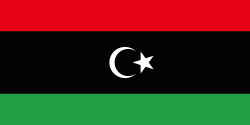Qasr Abu Hadi (Qasr Abu Hadi)
Qasr Abu Hadi (قصر ابو هادي) is a village with an estimated 4,890 inhabitants in the Sirte District of Libya. It is 2 km east of the Gardabya Airport and 20 km south of Sirte.
Former Libyan leader Muammar Gaddafi claimed to have been born in a goat-hair tent near the village on 7 June 1942.
Former Libyan leader Muammar Gaddafi claimed to have been born in a goat-hair tent near the village on 7 June 1942.
Map - Qasr Abu Hadi (Qasr Abu Hadi)
Map
Country - Libya
 |
 |
| Flag of Libya | |
Libya has been inhabited by Berbers since the late Bronze Age as descendants from Iberomaurusian and Capsian cultures. In classical antiquity, the Phoenicians established city-states and trading posts in western Libya, while several Greek cities were established in the East. Parts of Libya were variously ruled by Carthaginians, Persians, and Greeks before the entire region becoming a part of the Roman Empire. Libya was an early center of Christianity. After the fall of the Western Roman Empire, the area of Libya was mostly occupied by the Vandals until the 7th century when invasions brought Islam to the region. In the 16th century, the Spanish Empire and the Knights of St John occupied Tripoli until Ottoman rule began in 1551. Libya was involved in the Barbary Wars of the 18th and 19th centuries. Ottoman rule continued until the Italo-Turkish War, which resulted in the Italian occupation of Libya and the establishment of two colonies, Italian Tripolitania and Italian Cyrenaica (1911–1934), later unified in the Italian Libya colony from 1934 to 1943.
Currency / Language
| ISO | Currency | Symbol | Significant figures |
|---|---|---|---|
| LYD | Libyan dinar | لد | 3 |
| ISO | Language |
|---|---|
| AR | Arabic language |
| EN | English language |
| IT | Italian language |















